Recognizable as a VW Bus, but what is it competing against? Will its charm endure?
The 2025 Volkswagen ID.Buzz, a modern electric version of VW’s iconic 1960s Microbus, is set to debut after a long seven-year wait. This stylish three-row electric vehicle will be available at dealerships in November and December, with priority given to those dealers who previously had higher sales of VW’s ID.4 compact electric crossover.
The ID.Buzz is priced between $61,500 and $71,500, offering EPA-rated combined ranges of 234 miles for the base rear-wheel-drive model and 231 miles with optional 4Motion all-wheel drive. North America will receive a longer-wheelbase version not available in Europe, offering six or seven seating options depending on the trim. However, the commercial panel-van version will not be sold in the U.S., a decision tied to the “chicken tax” regulation.
A media drive took place in mid-October in the San Francisco Bay Area, known for having one of the highest per capita concentrations of electric vehicles in the U.S., second only to Los Angeles. The event commenced with a convoy of more than a dozen Buzzes driving down the famous switchbacks of Lombard Street for a group photo, followed by stops for pictures under the Golden Gate Bridge and along the picturesque Marin County coastline.
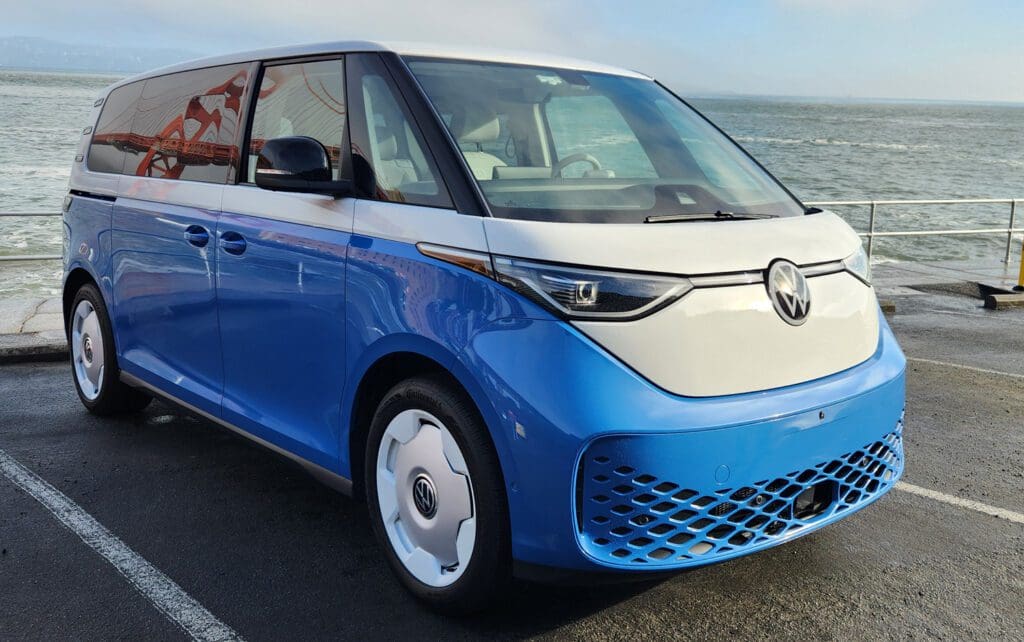
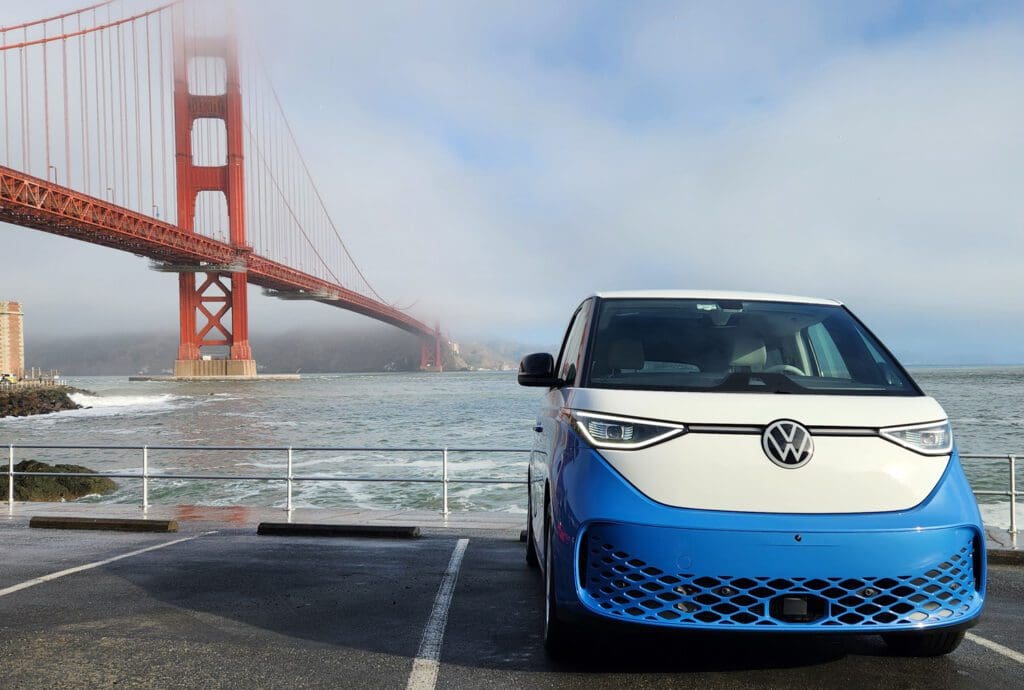
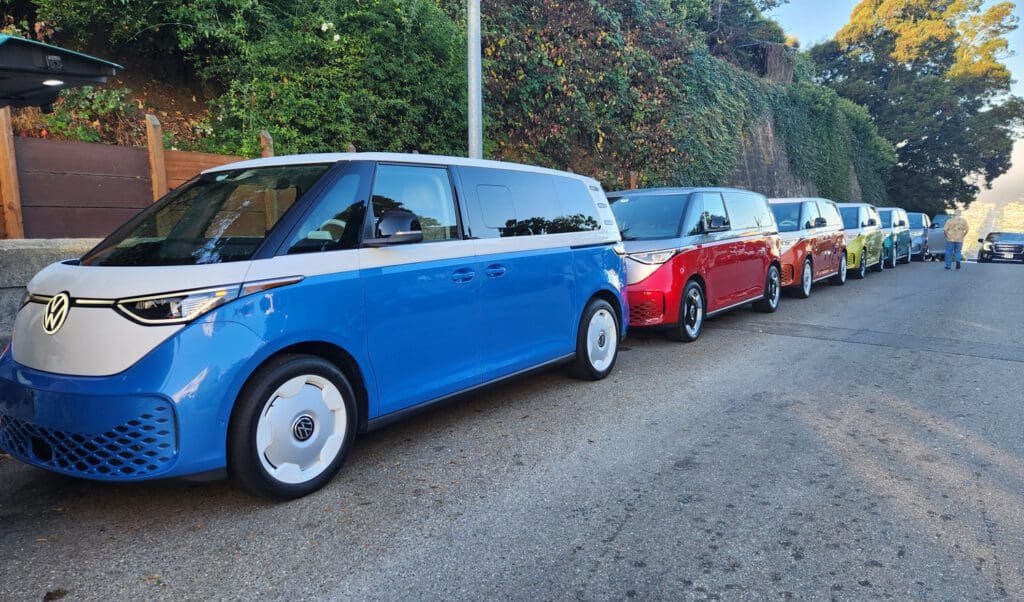
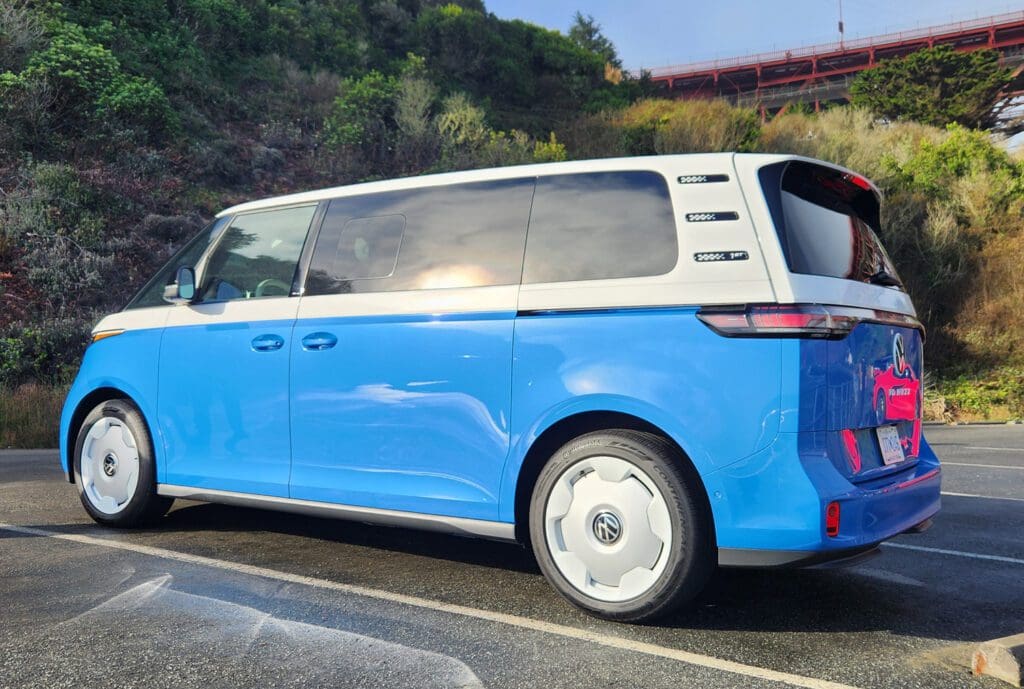

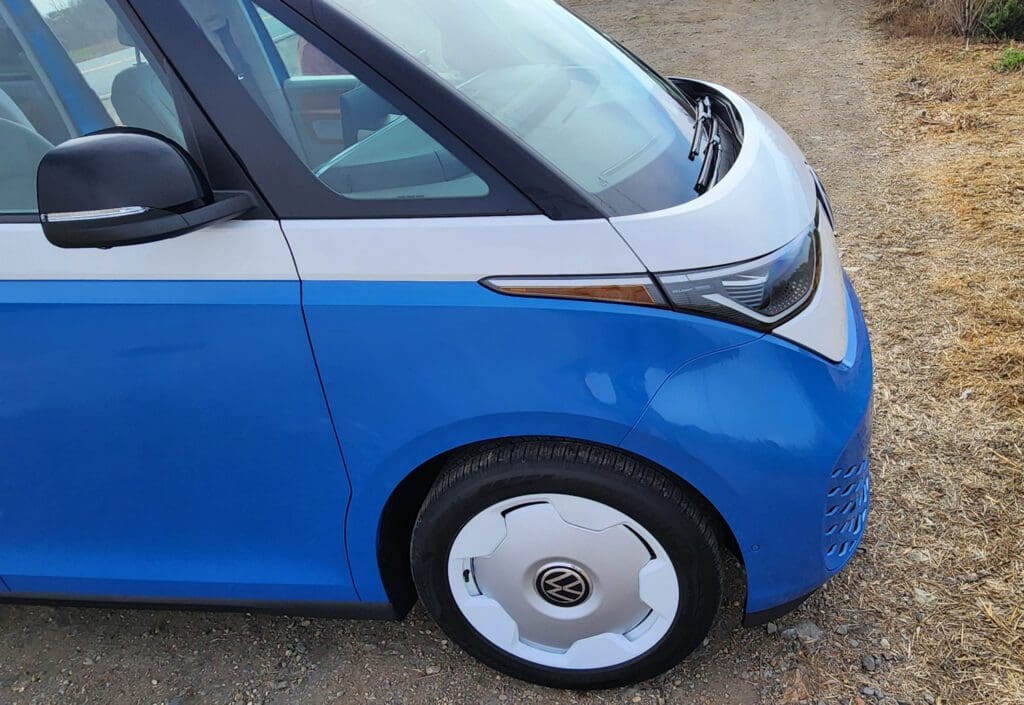
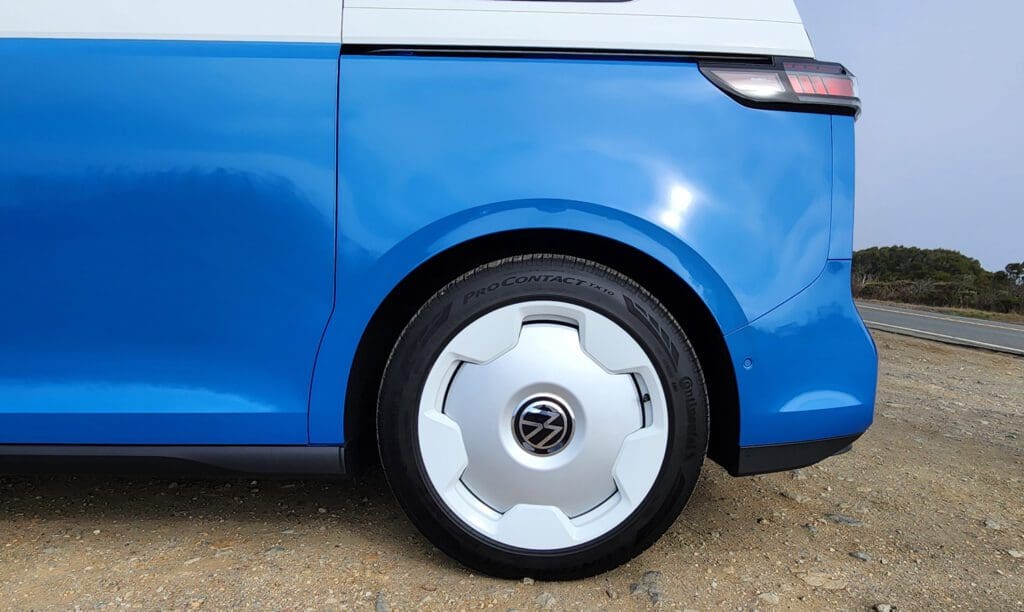
Photos by John Voelcker.
Distinctive design and two-tone options
The ID.Buzz garners curiosity and attention from bystanders much like it did upon the announcement of its production in August 2017. Its iconic appearance is marked by a prominent illuminated VW badge on the front and one of eight potential two-tone color schemes. Most colors are a white top over a vibrant selection including orange, yellow, green, blue, “blue charcoal,” silver, or gray. However, the combination of silver over Cherry Red seems less appealing. Three solid colors—black, white, and silver—also feature in its design. North American customers can choose from three unique interior “color worlds” not available in other markets: Copper, Dune (ivory), and Moonlight (deep brown). Notably, Volkswagen has chosen not to include the traditional all-black German interior in the Buzz, a welcome change.
The Buzz has a tall and blocky profile, with a short nose effectively concealing the distance between the windshield and the front occupants. This design provides a much safer crumple zone than the original Type 2 that had drivers’ feet just 18 inches from potential impact.
Key elements of its design include very short overhangs, excellent visibility from upright seating and numerous windows, significant interior volume relative to its size, and rear-wheel drive. While it’s powered by an electric motor rather than the air-cooled flat-4 combustion engine of its predecessor, the essence remains the same.
While the front and side views are attractive, the angular vertical rear might be the least successful aspect of its design. Nonetheless, it reveals a spacious 18.6 cubic feet behind the third row, expandable to 75.5 cubic feet by removing the third row and an impressive 145.5 cubic feet with the second row folded down (which cannot be removed).
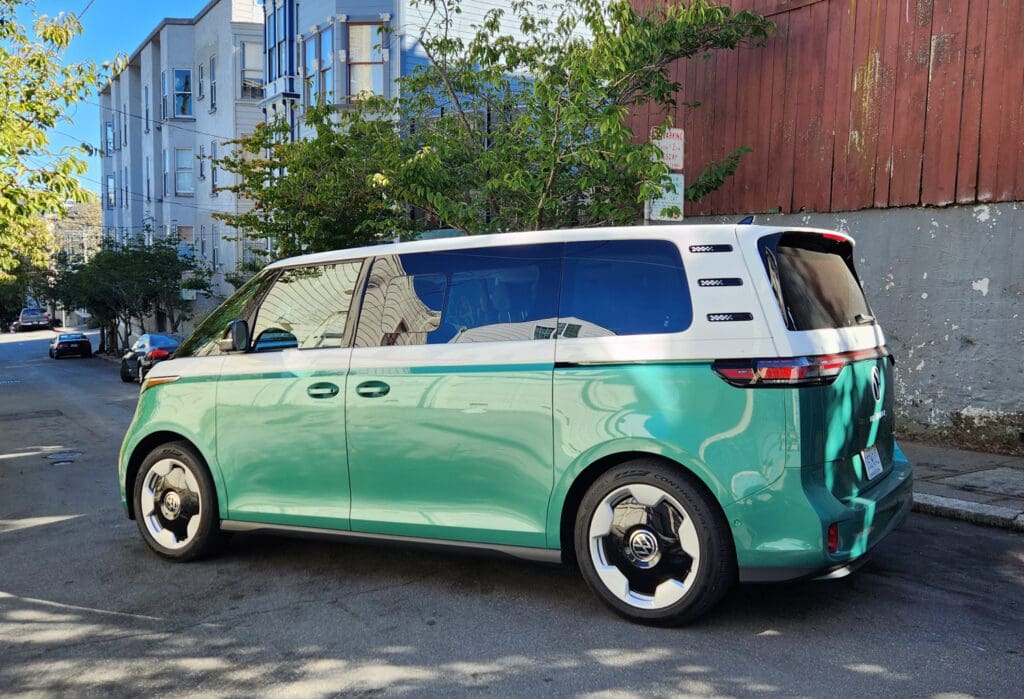

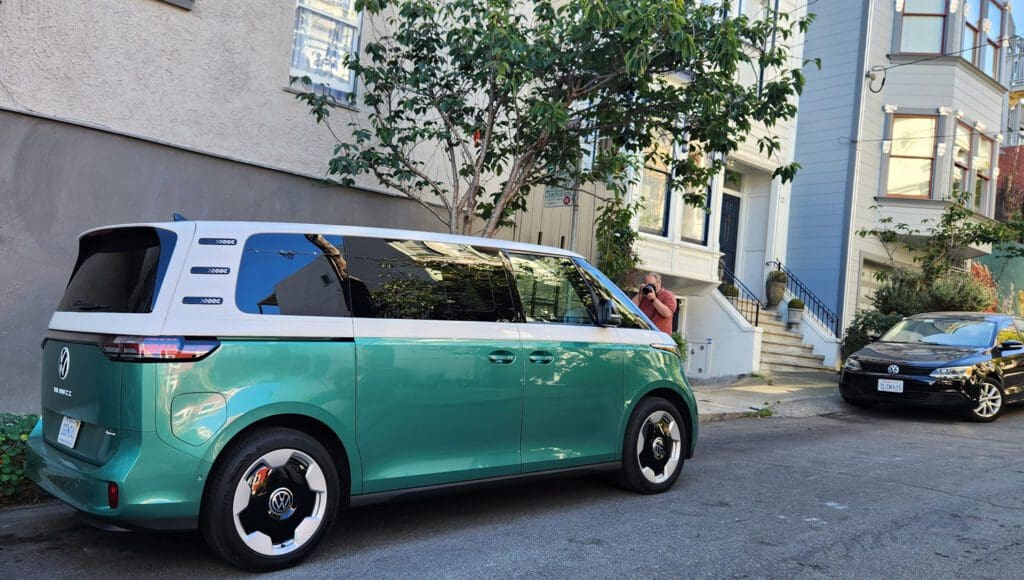


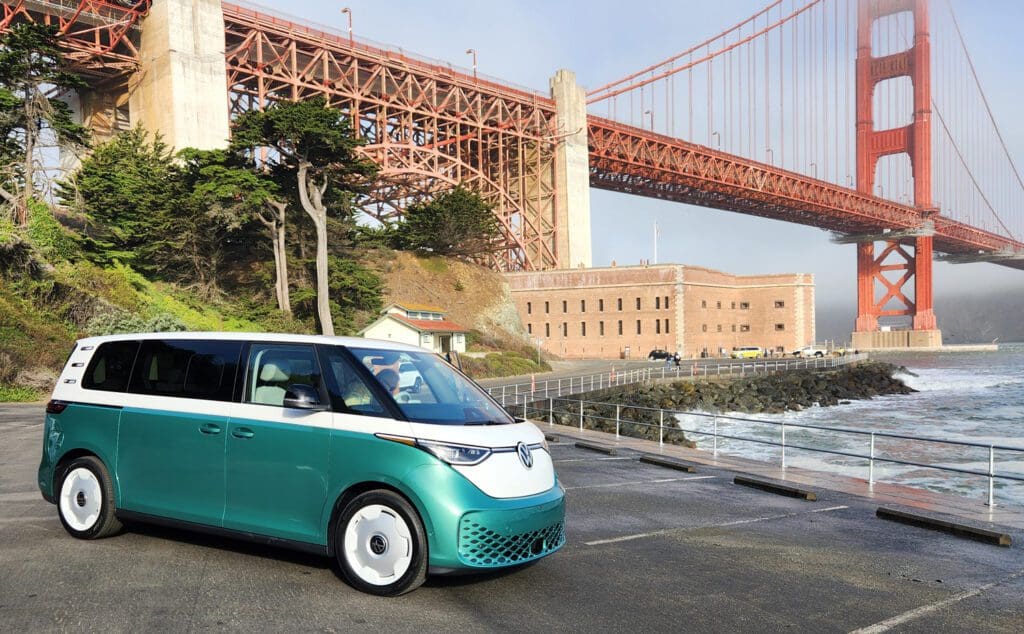
Photos by John Voelcker.
Tight turning radius, dependable performance
All U.S. versions of the ID.Buzz are equipped with a 91-kilowatt-hour (gross) battery pack. The standard model is powered by a 210-kilowatt (282-horsepower) rear-wheel-drive motor that produces 413 lb-ft of torque. The optional 4Motion all-wheel-drive system adds a 40-kW (53-hp) motor for the front wheels, delivering an additional 99 lb-ft of torque. The range between the two configurations is remarkably similar: 234 miles for RWD and 231 miles for the AWD.
During a drive down Lombard Street, it became evident that although the ID.Buzz is a larger vehicle—comparable in size to the VW Atlas Cross Sport midsize two-row SUV—its 37.4-foot turning circle makes it highly maneuverable (42.7 feet for the 4Motion AWD). It shares this nimbleness with the ID.4, a commendable trait made possible through its EV design.
Acceleration is not akin to that of a Tesla, but it surpasses the original Microbus, which was notoriously slow. Volkswagen claims a 0 to 60 mph time of about 6.0 seconds, though exact testing was not performed.
The regenerative braking system isn’t particularly robust, possibly due to the power-to-weight ratio. While there’s no one-pedal driving experience to come to a complete stop, the regenerative feeling is notably stronger in the AWD model, which features the additional motor—albeit, it also introduces heavier steering.
Overall handling is safe and predictable, though not particularly exciting. Even equipped with 20-inch wheels, drivers will notice the tires working hard to support the 3-ton vehicle, particularly with more vigorous driving. This may be less of a concern for everyday tasks like running errands or school pickups.
Many identified issues with VW’s user interface have previously been discussed in-depth. For instance, certain interfaces include back buttons while others do not, and a vehicle icon in the header of the 12.9-inch center display shows one set of options, whereas a similar icon in the main functions display leads to an entirely different menu—creating confusion.
Volkswagen’s onboard Level 2 charger operates at 11 kilowatts if the charging station allows. DC fast charging can provide up to 200 kilowatts under ideal conditions. Unfortunately, there was no opportunity to charge the Buzz during the brief test period, but future longer tests will evaluate this capability.





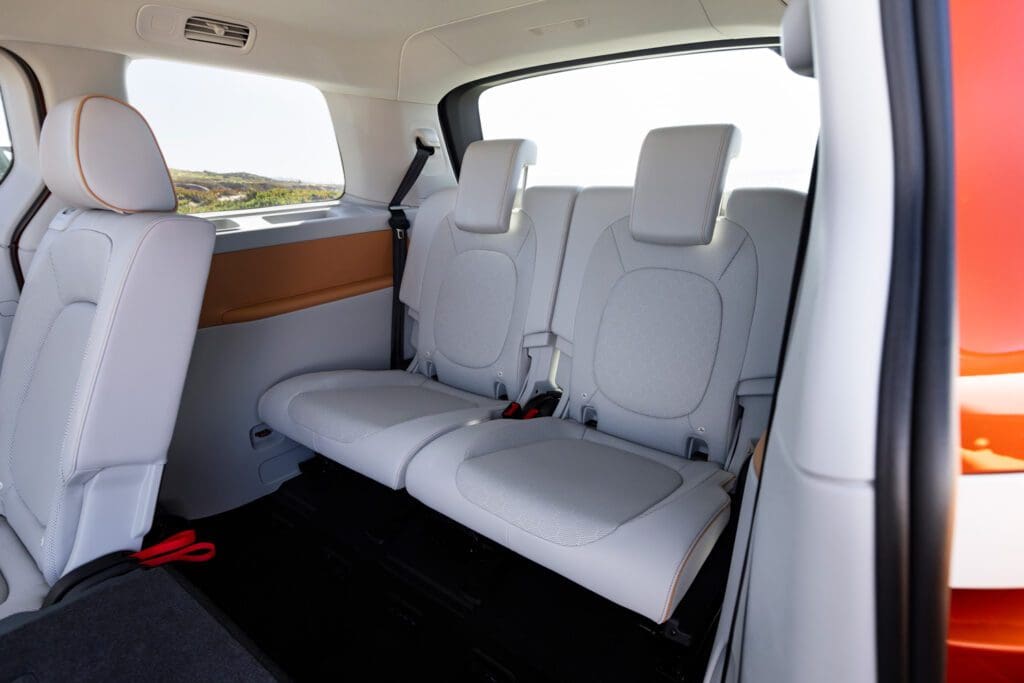
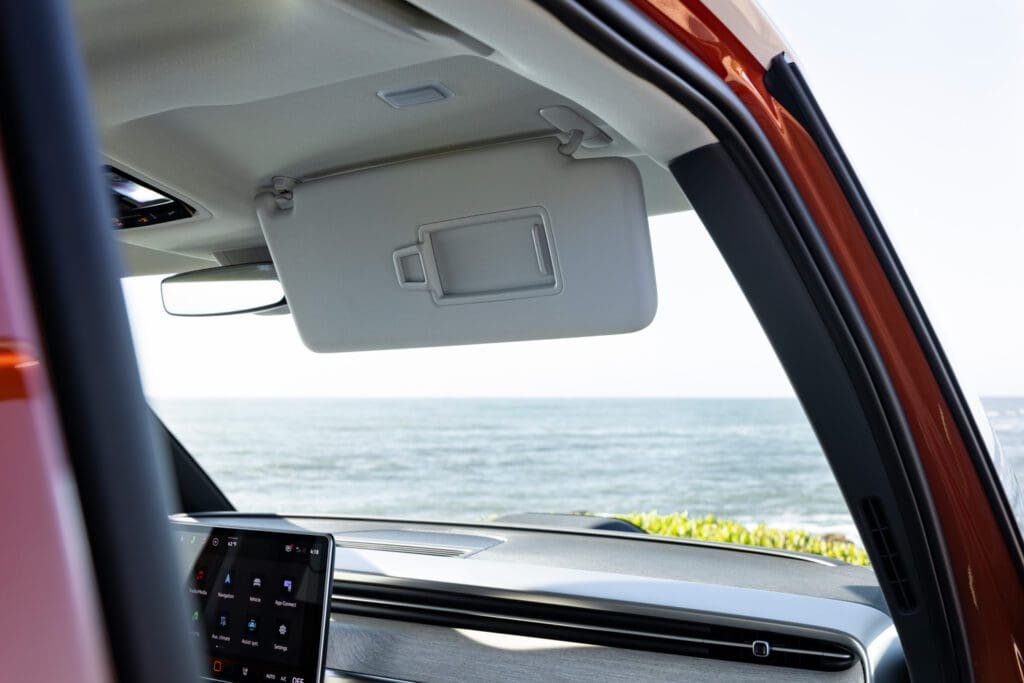
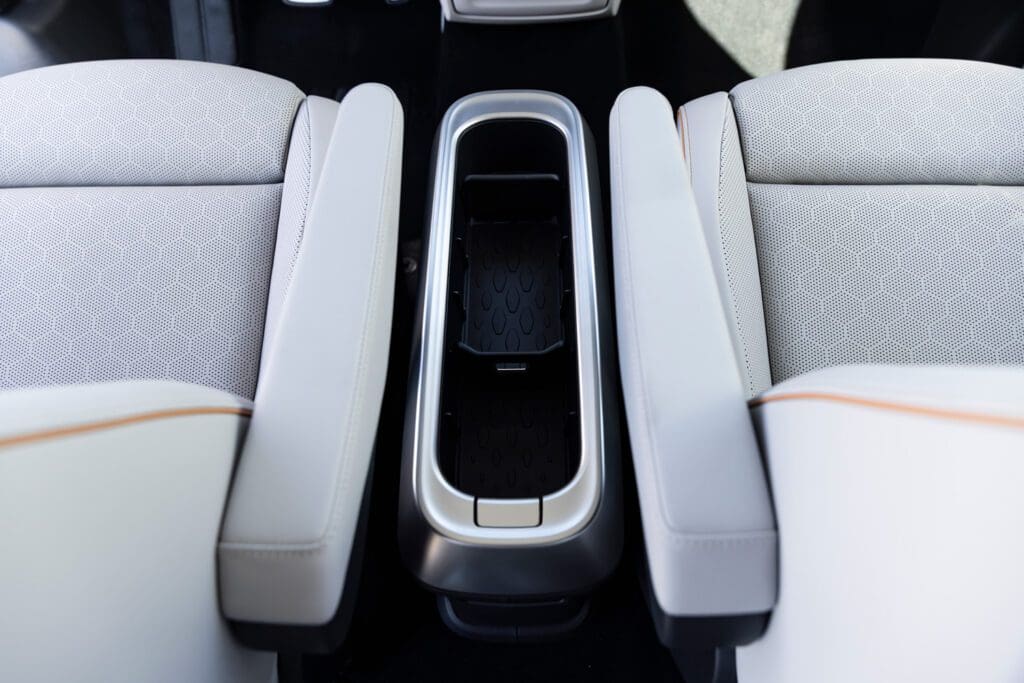
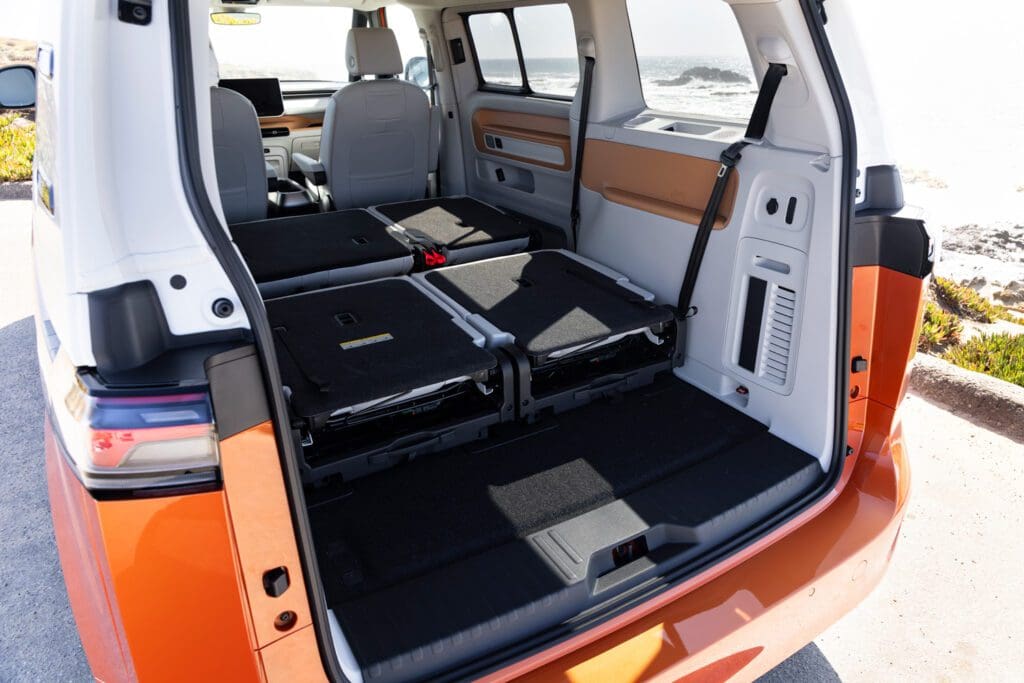
Photos by Sam Dobbins, courtesy of Volkswagen of America, Inc.
Spacious seating, excellent sightlines
Shorter drivers may need to adapt to stepping into the Buzz, which would benefit from a flatter step in the door versus the present beveled metal sill. This situation makes the steering wheel an informal grab handle, and the true grab handle located above the door seemed fragile during testing by two middle-aged male drivers.
Once you’re inside, the leatherette seats are quite comfortable, with excellent visibility and an airy feel to the cabin, thanks to the largest glass roof VW has offered, which also features electrochromic “smart glass” that shifts quickly from transparent to heavily tinted with the press of a button.
The second row can be configured as either a three-seat bench or two captain’s chairs, with ample space for easy access to the third row of seats. Volkswagen claims that the ID.Buzz offers superior third-row legroom compared to all vehicles sold in North America. While exact comparisons with the Chrysler Pacifica, Honda Odyssey, or Toyota Sienna weren’t made, the third row did feel as spacious as the generous Pacifica, currently the benchmark for third-row space.
For added utility, its “Buzz Box” center console can be repositioned or completely removed. However, it currently falls short in the number of practical storage compartments and cubbies compared to a typical Hyundai. For example, while there are cupholders in the console, the door pockets don’t feature molded spaces for bottles, leading to items potentially rolling around. On a positive note, many storage areas include rubber mats to keep smaller objects stable.
A first for a Volkswagen vehicle in North America is the inclusion of a retractable trailer hitch in certain ID.Buzz models. The towing capacity is rated at 2,600 lbs for standard rear-wheel drive and 3,500 lbs for the AWD, though this likely affects real-world range negatively. Unfortunately, the test vehicles during this preview didn’t have the hitch installed for evaluation.
Understanding the ID.Buzz in the marketplace
One of the foremost queries regarding the ID.Buzz pertains to its competition. VW avoids labeling it a minivan, noting that only 3 percent of potential customers identify as minivan owners. A considerable 57 percent of interest comes from those driving midsize SUVs, with 28 percent from full-size SUV owners.
This has led Volkswagen to present a comparison slide featuring a diverse lineup of vehicles: Chevrolet Suburban, Chrysler Pacifica (plug-in Hybrid), Kia EV9 (an electric vehicle), Rivian R1S (another electric vehicle), Toyota Sienna, and VW’s own Atlas. While the ID.Buzz is shorter than these models, it boasts the best headroom in its second and third rows and the most cargo space, even exceeding that of the large Chevy Suburban by a cubic foot.
However, the question remains: will consumer interest in the ID.Buzz persist? VW’s history with two generations of the New Beetle indicates that vintage designs tend to attract initial sales but can quickly decline in popularity. Will the Buzz be different? Only time will tell.
Pricing and features
The starting price for the 2025 Volkswagen ID.Buzz is $61,545 for the Pro S model, which is rear-wheel drive only. Standard amenities include powered sliding side doors and a tailgate, 12-way adjustable heated and ventilated front seats, heated seats for the outboard second-row positions, three-zone climate control, eight USB-C ports, a 12-volt outlet in the load bay, and a 120-volt socket in the front row.
Upgrading to the Pro S Plus adds $2,500 and introduces a retractable tow hitch, a head-up display, and captain’s chairs in the 4Motion AWD version (the latter available for $695 on the RWD Pro S). Other optional features for all Pro S Plus versions include two-tone paint ($995) and a panoramic glass roof ($1,495).
Lastly, the limited First Edition package comes at an additional $2,000, raising the total to $67,045. This package essentially extends the Pro S Plus offerings to include two-tone paint, a panoramic glass roof, powered doors, 20-inch wheels, Heritage floor mats, and exclusive badges.
For both the Pro S Plus and First Edition models, adding 4Motion all-wheel drive increases the price by $4,500. Notably, all listed prices include a mandatory $1,550 destination fee.
Volkswagen sponsored airfare, lodging, and meals for the purpose of this first-person drive report.
.

